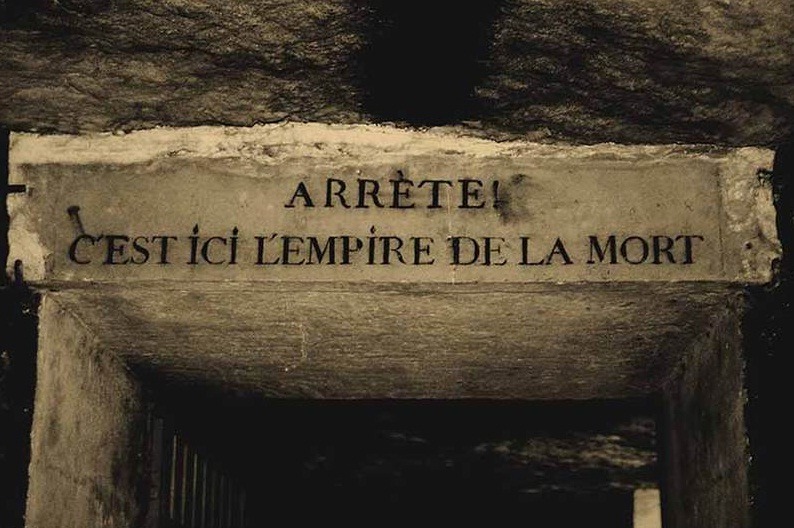The Catacombs are underground ossuaries (depository for the bones of the dead) in Paris, France, which hold the remains of more than six million people in a small part of a tunnel network built to consolidate Paris’ antique stone quarries.
“Though nearly all members of our Lynch family (Bev, Zen, Sofia and Coco) thoroughly enjoyed the one-hour Catacombs walking tour, I regrettably did not participate due to my intense and irrational claustrophobia… sorry Catacombs lovers!”
-Randy Lynch
 Paris Catacombs Fast Facts
Paris Catacombs Fast Facts
-
As you cross the entry way to the actual Catacombs below, the sign above reads: “Arrete! C’est ici l’empire de la Mort” (“Stop! This is the empire of Death”).
-
The depth of the public tunnels equate to the height of a five story building, or 20 meters/65 feet. The total layout of the tunnels is said to be more than 2,000 acres(!).
-
The total area of the public tunnels is about 11,000 sq. meters or 118,000 sq. feet.
-
When visiting the public section of the tunnels, it will take you about one hour and you can expect to walk roughly a mile.
-
Going down to the tunnels requires you to descend approximately 131 steps, and to come back up you’ll need to climb approximately 112 steps.
-
As the constant temperature of the Catacombs is 57 degrees Fahrenheit, you’ll need a heavy sweater or jacket to keep warm!
History of the Catacombs
By the 17th century, Paris had become a major European hub, leading to a rapid influx in population. By this time, enough people had lived and died in the city to overfill the existing graveyards which even caused newly buried people to become exposed(!!!). This led to serious health concerns as well as economic issues (as far as many perfume shops losing business from the foul smell nearby), and a decision to transfer the protruding remains to an underground location. In 1763, Louis XV issued an order banning any further burials in the city but took no further action, which only lasted so long. The Parisian people came together and decided that the best solution would be to utilize the underground tunnels created in the 13th century when the city was mining limestone to build the Paris we all know and love today. The 800 hectares (equivalent to 200 miles!) of labyrinth had been empty and unused for centuries, and seemed to be the perfect solution to this pressing issue.
In 1786, this idea was put to action and the city began moving the remains of the deceased to the underground tunnels. The site was consecrated as the “Paris Municipal Ossuary” on April 7th, 1786, and took on the mythical name of the “Catacombs” from this day on (the name was given in reference to the Roman Catacombs which fascinated the public since its discovery). At the time, the chosen location of the Catacombs was outside the capital at the former Tombe-Issoire quarries under the plain of Montrouge. It began with the Les Innocents graveyard located in the heart of the city and with the most pressing overflow. This site was so bad, that giant pits were dug up one at a time and filled with roughly 1,500 bodies before being closed again, leaving the sanctity of individual and marked graves off the table. In all, it took the city about 12 years to move all the inundated remains throughout the city into the Catacombs, with an estimated 6-7 million bodies having been transferred and neatly and respectfully stacked. Remains moved varied anywhere from recently deceased to the bones of individuals of the Merovingian Era, from more than 1,200 years prior.
Après la Création (After Creation)
The last body was placed in the Paris Catacombs in 1859. Over the years, the Catacombs have aroused curiosity all over the globe. Beginning in 1809, the Catacombs were officially opened to the public for viewing but this was only possible with special permission and an appointment. A register was placed at the end of the circuit where visitors were able to write their impressions of their experience. The register was filled quite quickly as these visits became popular for both French nationals and foreigners alike. As years went on, the ossuary became the resting place of many illustrious individuals such as Jean-Paul Marat and Maximilien de Robespierre, both critical figures during the French Revolution.
Visitors to the Catacombs include some prominent figures, including the Count of Artois and Charles X with a group of court ladies in 1787, Francis I and the Austrian Emperor both taking a tour in 1814, and even Napoleon III descended into the Catacombs with his son in 1860.
During the 19th century, visiting arrangements and permissions constantly changed, from closing completely to only allowing visitors on a monthly or quarterly basis. Today, we are fortunate to have the opportunity to visit the Catacombs any day (except Mondays!) without any kind of pre-authorization needed. Annually, the Catacombs welcome roughly 550,000 visitors to its depths, if you dare!

Visiting the Catacombs: What You Need to Know
-
The Catacombs are open Tuesday-Sunday from 9:45am-8:30pm, with a final entry limit at 7:30pm.
-
Insider Tip: The Catacombs is the least busy around the early and late hours of the day. Since you’ll have to purchase a timed-entry ticket, we recommend the 10:00am or 7:00pm entry ticket.
-
-
The entrance to the Catacombs is located at 1 Avenue de Colonel Henri Rol-Tanguy. You can find it right across the street from the Liberation of Paris Museum and the Denfert-Rochereau metro station! However…
-
You can’t exit where you enter. The exit, along with the boutique, is located a few blocks away, at 21bis Avenue René-Coty.
-
Tall people, beware: while there is no official height limit to the Paris Catacombs, certain tunnels and spots along the path can feel pretty claustrophobic. Visitors over 6 feet tall report having to duck down at times in order to prevent hitting their head on the trail.
-
Make sure to bring your glasses, because the lighting is quite dim! While seeing dogs are permitted, white canes are not.
-
Other things not permitted in the Catacombs:
-
Strollers
-
Large Bags
-
Motorcycle Helmets
-
Tripods
-
Eating
-
Drinking
-
Smoking
-
Touching anything
-
Attempting to illegally explore the extensive underground tunnels of Paris beyond the Catacombs.
-




